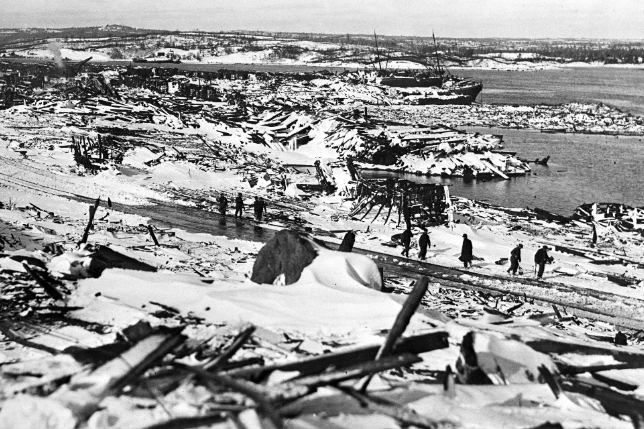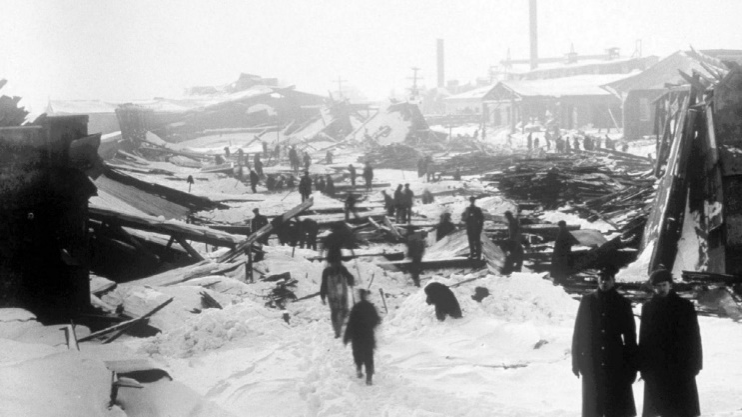
10:13 A.M.
December 6th, 1917
Boston and Halifax were not friends. In fact, Halifax, Nova Scotia, Canada had fought for or supported every cause, battle or confrontation against the Americans since the American Revolutionary War. It was that conflict that sent 30,000 British Empire loyalists fleeing from New York and New England, who became the foundation of Halifax’s 1917 population.
No, Halifax and Boston were not friends. One of Nova Scotia’s favorite sons, Joseph Barss Jr., gained his reputation by capturing, sinking or burning dozens of American ships in the war of 1812. Before that, Dr. William Johnston Almon and Jock Fleming risked their lives sneaking a Confederate ship past Union forces under cover of darkness. And most recently, some Canadians resented the neutrality of America in the Great War (WWI).
As for Boston, the antagonism was mutual. Bostonian congressmen were advocating annexing Canada as late as 1911 (You can imagine how the Canadians warmed to this idea). No, Boston and Halifax were not friends.
World War I had been taken the lives of so many, with no end to the slaughter in sight. So the Americans – having newly entered the war – decided a radical step needed to be taken. They loaded six million pounds of explosives on an old, poorly maintained French ship (the Mont-Blanc) and sent it off to Europe via Halifax.
Because of contact with another vessel in the harbor, at 9:04:35 A.M. Thursday, December 6, 1917, the Mont-Blanc exploded – all 6 million volatile pounds, instantly wiped out much of the city. What a cataclysm! Two-thousand killed; 9000 injured; nearly all structures within ½ mile radius obliterated. Trees snapped, rails bent, ships tossed about like toys, a 30-foot tsunami and then the “city” got mayonnaise with 16 inches of snow the next day, complicating relief efforts. It was unlike anything the world had ever seen.
By 10:13 A.M. a telegram about the disaster reached a number of cities, including Boston. It was brief and sketchy – few details. Halifax was equidistant from Montreal and Boston by train, but twice as close to Boston by sea. So it was not a question of whether the closest major city could help Halifax, but whether Boston would.
Boston and Halifax were both sea towns, both involved in shipping and for the first time, on the same side of a war. And Boston was still home to thousands of Halifax cousins who visited one another and Halifax transplants like James McLaughlin, the architect of Fenway Park. Boston had something no one else had: a Committee on Public Safety. Boston was prepared for something like this.
The telegram reached Henry B. Endicott, the shoe magnate who chaired the Massachusetts Relief Commission. He promptly made a visit to Governor McCall at the State House at 11:00 A.M. The vague telegram left the two men without knowing what was needed, but they wasted no time firing off a telegram to the mayor of Halifax. It included, “. . .Understand your city in danger . . . Massa-chusetts ready to go the limit in rendering every assistance you may be in need of. Wire me immediately.”
While waiting for a response, Governor McCall called a meeting of his recently formed Committee on Public Safety for 2:30 P.M. Then walked a sort distance to convene a “town hall” meeting. There – on the spot — one hundred leaders from across the state formed the Massachusetts-Halifax Relief Committee.
McCall sent a wireless message, again offering unlimited assistance. After confirming that Halifax had not replied to the governor’s first or second communication, and that no one in Washington had any information either, the Committee decided to take action anyway, organizing a relief train to leave that evening.
McCall’s third message included: “Realizing time is of the utmost importance we have not waited for your answer but have dispatched a train with surgeons, nurses, and other medical assistance. McCall.”
That night, a little after 10:00 P.M. — only 13 hours after the explosion — a relief train departed from Boston with many boxes of medicines, eleven surgeons and doctors, an ophthalmologist and anesthetist, ten nurses, six American Red Cross workers (each with a different specialty), four leaders of different railroads, and five reporters. All sent off without receiving answers from Halifax.
Reporters broadcast this event to the rest of Canada and America. Their efforts rallied significant aid.
As the train got nearer and nearer to Halifax, and more doctors, nurses, supplies, and food was taken on board, the Americans became aware of the magnitude of the situation. The leaders on the train wired back to Boston to send building supplies, especially glass (since thousands of windows have been shattered).
Within 24 hours, 90% of the wounded had been treated, a remarkable feat. Sir Robert Borden, the premier of Canada, cut short a trip to aide his home town. Likely that was expected. What was not expected was “. . . the first and most valuable assistance came from the ancient foe beyond the Bay of Fundy,” meaning the United States. “Boston, that rebellious soul of a nation that had, just six years earlier, spoken openly on the floor of Congress about annexing its longtime neighbor, was now coming to its rescue, unbidden, in full measure.” (Bacon, page 413).
The British empire responded with huge gifts (Australia $250,000; British government £ 1 million; the Province of Ontario $100,000; London citizenry $600,000, etc.).
Sir John Eaton, president of Eaton Company, one of Canada’s biggest department-store chains, packed several train cars with food, experienced staffers, a medical unit and enough goods to open a clothing and supply depot that carried building materials and other necessities, and headed for Halifax. If you had a requisition from your pastor or a committee chairman, anything you wanted was free. How much Eaton gave away is unknown, but the estimates place it in the six figures (millions in today’s dollars). He gave it all away on one condition: there was to be no publicity. Small gifts poured in.
The Boston train arrived about 6:00 A.M. Saturday morning (a scant 36 hours after the blast). Along the route, leaders aboard the train had increasingly ratcheted up orders for supplies and people to come from Boston to help. Reporters told the enormity of the destruction, but also accounts of grit, determination and downright heroism. These dispatches soon inspired individuals, cities, businesses, states and national governments around the world to give generously to Halifax relief.
When the letter from Governor McCall reached the relief headquarters in Halifax, a leader wept. Canadian Premier Border, who had been swept into office by anti-American annexation sentiment – fears he had stoked – met the American delegation and expressed deep gratitude. What a turnaround!

They selected Bellevue Building, the best available. Badly damaged – not a window or door remained whole and water and ice were on the floor of every room – the Bellevue would be the American’s temporary hospital. The Americans set to work.
By 12:30 P.M., Bellevue received its first patients, joining five other temporary facilities, and adding many beds to the city’s capacity.
The previous day, in historic Faneuil Hall, Governor McCall and the Massachusetts Relief Committee had a follow-up meeting and decided to send Halifax $100,000 (equivalent to $2 million today); plus more medical and trade personnel and two supply ships (The Calvin and the Northland). Before their departure, newspapers informed Bostonians where these two ships were, so the docks overflowed with Samaritans eager to contribute. People cheered when the ships departed.
Chicago chipped in $250,000 as the mayor wrote, “Halifax had been among the first to assist us after the 1871 fire so Chicago should return the kindness” (Bacon, page 451). On December 10th, the New York pharmaceutical supplier McKesson & Robbins wired that they were sending $500 worth of medical supplies (equivalent to $10,000 today). Halifax responded that they needed chloroform, tincture of iodine and antistreptococcic serum. New York sent pre-fab homes. Portland, Maine sent five carloads of telegraph material, groceries and dry goods. The governor of Maine sent 2000 blankets and 1000 cots, plus medical officers, crews of carpenters and other volunteers. Schenectady gave $4000. While $4000 may not sound like much, in 1917 the average American worker earned about $800 per year . . . so $4000 = $130,00 in today’s dollars.
Boston continued to send money, supplies, personnel, even a benefit concern. The Northland sailed north with $100,000 worth of supplies and $25,000 worth of trucks, plus gas and the chauffeurs needed to operate them.
Later, the Haligonians gratefully praised Boston for their timely help. Boston and Halifax were not now friends.
Source: The Great Halifax Explosion, by John U. Bacon; Harper Collins Publisher, 2017


Recent Comments